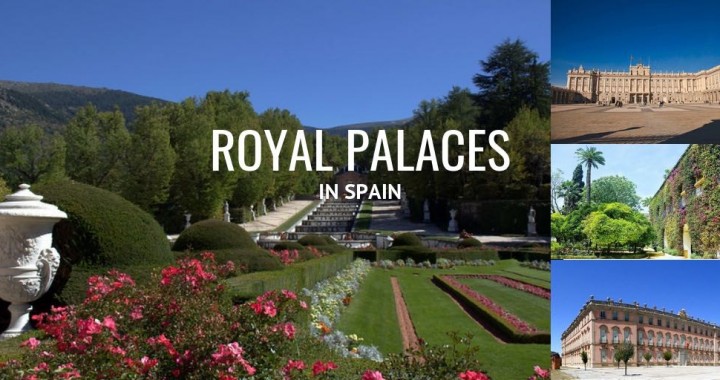Royal Palaces in Spain are a treat to visit. Not only are they wonderful buildings in splendid surroundings, many with manicured gardens to stroll in (especially welcome on hot sunny days) – you also get a deep insight into Spain’s powerful role in world history as you browse the paintings, sculpture and tapestries. If you enjoy visiting and photographing stately homes and palaces read on, then get in touch with us below at Totally Spain to customize a tour just for you featuring the Best Royal Palaces in Spain and more….
Royal Palaces in Spain
1 The Royal Palace in Madrid
First stop has to be Madrid’s royal palace. Standing on the site of a 9th century Alcazar (which means a castle or fortress), today’s Royal Palace replaced another former palace that was destroyed by fire in 1734. Building began in 1738 under the instruction of Italian architect Giovanni Battista Sacchetti. It was completed in 1764 by another Italian architect Francesco Sabatini (who designed the much-loved Puerta de Alcala also in Madrid).
With 3,418 rooms there’s a lot of palace to explore. There is some debate as to its style – with experts veering between baroque and neo-classical styles. It’s best known for its painted frescos and the artwork is pretty impressive – you’ll find paintings by Velázquez, Goya, Rubens, El Greco and Caravaggio. Plenty of great tapestries also. Historians will enjoy seeing Charles III’s bedroom designed by Sabatini and The Royal Armoury, hailed as the best European collection together with the Imperial Armoury of Vienna, which are both attributed to the Hapsburgs.
Why visit? It’s like a back catalogue in interior decoration as each of the rooms represents a period in time and a style in fashion. We love the Chinese Room for its colour. And the nearby gardens are wonderful too. Because of its size, and the crowds (almost 1.5 million people visited in 2016), make sure to pre-book your tickets (read why here) or get one of our expert guides to take you on a walking city tour that includes a guided visit of the palace.
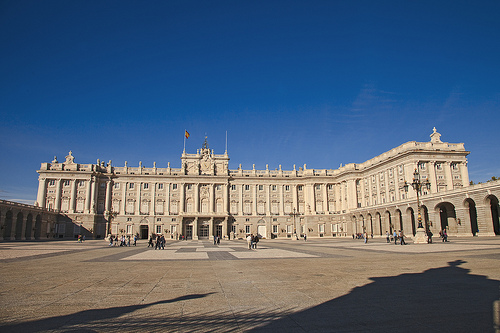
Madrid’s Royal Palace – with 3,418 rooms you might want to book our expert tour guide to show you the best and most poignant this city landmark. photo credit: Tomás Fano Madrid. Royal Palace. Spain via photopin (license)
2 Aranjuez Palace in Madrid
Just 40 mins from Madrid by rail or car, you’ll arrive at the Royal Palaces of Aranjuez commissioned by Philip II in 1561 (although much of what you see is actually from the 18th century). It’s a great day trip from Madrid city for gardening fans – and you’ll marvel how luscious this area is compared to its surrounding countryside, thanks to the very effective irrigation from the River Tajo.
Start your visit by exploring the Palace grounds. Make sure to see the woodland avenues of the Island Garden, the floral displays of the Parterre Garden, and the variety of trees in the Prince’s Garden. You can visit the Palace but we recommend a private guide or at the very least, an audio guide, as this is a huge building. Favourites include the Porcelain Room where you’ll find some of Spain’s best work produced by the Royal Pottery Works of the Buen Retiro here.
After you leave the Palace, leave some time to walk the old quarter of Aranjuez and stroll the streets of Infantas and El Principe – the names alone hinting to its royal connections.
If you’re travelling during the months of May, June, September or October, take the Strawberry Train to and from Madrid. And yes – you really will be served strawberries as you travel in a vintage style carriage from Principe Pio station to Aranjuez! Perfect for children, fans of history and railway enthusiasts. Want more excursion ideas from Madrid? See our day trip recommendations here.
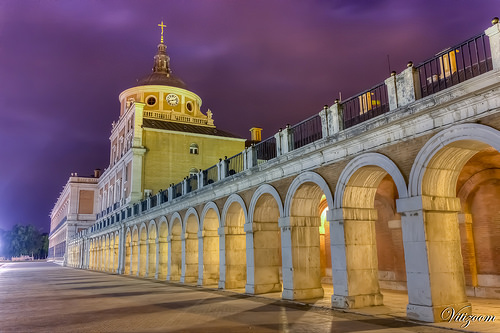
Just 40 mins from downtown Madrid by car or train, Aranjuez Royal Palace is crowd and queue-free! photo credit: Vitizoom Palacio de Aranjuez al anochecer via photopin (license)
3 El Escorial in Madrid
An hour’s drive or a little longer on a commuter train will get you up in the hills to El Escorial from downtown Madrid where you’ll find the enormous UNESCO-listed castle and monastery built for Phillip II who certainly knew how to choose a great location. The scenery is stunning all year round – and the cool breeze is especially welcome in Summer when Madrid gets very hot. You won’t be disappointed by this daytrip from Madrid.
The castle and monastery were completed in 1584 to showcase the monarch, the country and the might of Catholicism to the rest of the world. It’s scale and architectural and artistic wealth is significant. Where else will you find 15 cloisters, 13 oratories, 86 staircases, 88 fountains, 9 towers, 73 sculptures, 40,000 books (the library here is amazing) and 1,600+ paintings? And often overlooked but well-worth a visit – is the Royal Pantheon – a great way to learn about the Spanish Hapsburg and Bourbon royal families.
The grounds are equally impressive. From the monastery, start at the Friar’s Garden, visit the Orchard Garden and enjoy the views of the surrounding Guadarrama countryside. Gardeners and landscapers will be interested to learn about Phillip II’s modern approach to horticulture – including the Fresneda Royal Park nearby.
Before heading back to the big city, make sure to enjoy the town of El Escorial as well where you’ll find lots of pleasant tree-lined squares with dozens of cafes and restaurants to relax and eat a meal before heading back to the capital. El Escorial features in our guide to the best churches and cathedrals – you can read about the others here.

El Escorial is on a totally different scale to anything else you’ve seen! photo credit: Alan Cordova DSC_0084 via photopin (license)
4 La Granja in San Ildefonso (Segovia)
Just 80km from Madrid city , and 11km from the very charming city of Segovia, you’ll find the Royal Palace and Grounds of La Granja in the small town of San Ildefonso. Chosen by Philip V for his summer residence, he encharged architects Teodoro Ardemans, Andrea Procaccini and Filippo Juvarra to create this baroque palace alongside the royal chapel.
With its grand halls, fountains, the maze, the pond and multiple sculptures, this Palace is often compared with Versailles. In fact, the 146 hectares of forests and landscaped gardens were designed by René Carlier, who learned his trade under an architect of Louis XIV’s so the comparisons are not without reason.
Try to time your visit when the fountains are on (we can check this for you when you book your trip with us) and if possible when The Baths of Diana are on. (again, we can co-ordinate this for you). You should also visit the nearby Royal Glass Factory rebuilt by King Charles III in 1770. And Segovia itself, of course. You can’t miss out on the aqueduct, and the golden-hued historic centre. We’ve included it in our guide to Boutique Cities here.

The stunning grounds of the Palacio Real de La Granja de San Ildefonso. photo credit: manuel m. v.
Jardines de la Granja de san Ildefonso via Flickr (license)
5 Riofrio Palace in San Ildefonso in Segovia
If taxidermy freaks you out, you might want to skip this one. More of a hunting lodge than a palace, it was commissioned in 1752 by the second wife of Felipe V after her husband’s passing because she feared her stepson Fernando VI, might deprive her of La Granja Palace.
Built to the Milanese architect Virgilio Rabaglio’s designs (with exterior designing by Pedro Sexmini), there is a sense of Italian design with some believing it reflects the simplicity of St Peter’s Square in the Vatican. Its baroque influences are to be seen inside – especially at the main staircase. Today the Riofrío Palace houses a Hunting Museum which gives an overview of the entire historical process of hunting, from primitive times to modern times, hence the taxidermist warning at the outset. Art lovers will find much to enjoy – with works by Velázquez and Rubens, plus some impressive 18th century tapestries by the Royal Factory of Santa Bárbara (you’ll find tapestries from here at El Escorial also).
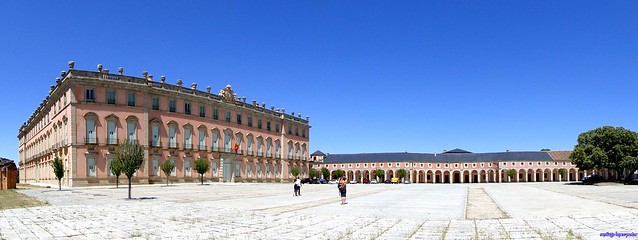
Riofrío was commissioned in 1752 by the second wife of Felipe V. photo credit: santiago lopez-pastor Palacio Real de Riofrío via Flickr (license)
6 Magdalena Palace in Santander
What started out as a Summer residence for King Alfonso XIII quickly turned into a Summer Palace thanks to the local team of architects Gonzalo Bringas (1880-1943) and Javier González de Riancho (1881-1953). At roughly 5,500 square metres it certainly wasn’t a Summer chalet. King Alfonso and his wife Reina Victoria arrived for the first of their seasons in Santander in 1913 and continued doing so up until the declaration of the Second Republic in April 1931. In 1932 the Menendez Pelayo International University (UIMP) took over the building and it continues to function today and plays host to heads of state, government ministers, politicians, leading academics, writers and musicians who participate in the annual summer university programme.
Today you can visit the palace on a guided tour. The grounds are open to the public free of charge and we defy you not to adore the wonderful views of the bay with direct access to some of the prettiest city beaches. Perfect for a paddle and a picnic! If you didn’t pack your sandals, stay by the Palace and enjoy the sculpture garden for a quiet moment.
When in Cantabria – you might also want to visit the Palacio de Sobrellano – in Comillas – just a 40 min drive away. Commissioned by the first Marquis of Comillas in 1882 and intended to house the Royal Family on their visits to the area – it is well worth a visit – along with the nearby chapel where Gaudi was commissioned to design some furniture. Right beside you’ll find the stunning Gaudi-designed Capricho! Read more about Santander here and Comillas here. And check out these 21 iconic images that define Cantabria and our Northern Spain Parador Tour.

What was supposed to be a Summer residence quickly became a Summer Palace! Magdalena Palace in Santander. Pic: PamelaCahill.com
7 Royal Alcazar in Seville
From up North to down South. Walking inside this fortress is like stepping inside history. Every period from the Arabic to Mudejar, Renaissance, Baroque and more is on show in this centrally-located UNESCO-listed site that is still used by the Spanish Royal Family when in Seville. It’s best remembered as the site for the marriage of Carlos V and Isabel of Portugal in 1526 who were cousins but were given the Papal blessing to wed. This union (and the building itself) have been the source of inspiration for many books and film-scripts – although the filming of the Game of Thrones here has eclipsed all the others put together!
The Palace itself has some wonderful tapestries and furniture and it’s a good way to learn about the lives of those who lived here – but it’s the gardens that will really linger on in your memory. The courtyards are stunning. Its structured gardens are a riot of styles and don’t be surprised to see some peacocks strutting their stuff. The main gardens and courtyards are the Charles V Garden, The Flower Courtyard, The Dance Garden, English Garden and Poets Garden. Enjoy the scents as you walk around too – citrus fruits and herbs. Watch out for the mosaics as well. This is a place where you can walk around at your own space and stop and start as you wish – as there is no fixed walking route. Go early to beat the crowds.
There’s so much more to see in Seville and Andalusia. Have a look at our Southern Spain Parador Tour for more ideas.

The stunning Alcazar in Seville and its amazing grounds and gardens can’t be missed! photo credit: Turismo de Sevilla Real Alcázar de Sevilla, en Andalucía, España via photopin (license)
8 Palacio de las Duenas in Seville
Whilst not a Royal Palace in the strictest sense, the Casa de Alba has been home to one of the most influential families in Spain and the Palace has been a meeting point for members of the European royal families and worldwide international personalities. King Alfonso XIII, Jacqueline Kennedy, Wallis Simpson, Prince Rainier III of Monaco and Grace Kelly are just some of the names to have been welcomed inside these doors. It was the private residence for the very colourful 18th Duchess of Alba – Cayetana Fitz-James Stuart up until her passing in 2014. According to the Guinness World Records, she was the most titled aristocrat in the world with 57 titles available to her.
Book your tickets in advance to avoid the crowds eager to enjoy the building that dates back to the 15th & 16th centuries – with its wonderful works of art and tables laid for state dining. The stables and gardens are a real highlight of this visit! Check out Unusual Andalusia here and other hidden gems in Spain here.

The leafy and luscious Duenas Palace in Seville is owned by the Casa de Alba. photo credit: Palacio de las Duenas, Seville
9 Olite Palace/Castle in Navarre
Those of you who enjoy their history will know that Spain is an amalgam of regions – many of which had their own leaders or royalty. Navarre is just one of these and we recommend visiting (and staying at) the Palace of Olite. Built for King Carlos III and his wife Leonor on the remains of an ancient Roman fortress, this Palace/Castle covers one-third of the old part of the town and is considered one of the most interesting Gothic complexes in Europe.
Declared a National Monument in back in 1925, a section of the building is now part of the Parador chain of luxury hotels with another being fully open to the public. That’s where you get to explore the meticulous restoration of the building including its many towers and galleries, carried out in 1937. The gardens also tell a story or two or the lifestyle of the royals – check out the King’s Gardens and ask what animals he kept there. If you can, why not stay at the Palace? We’d love to put together an itinerary for you. Check out this sample route that includes Olite in a Parador itinerary from Barcelona to Bilbao taking in the Pyrenees.
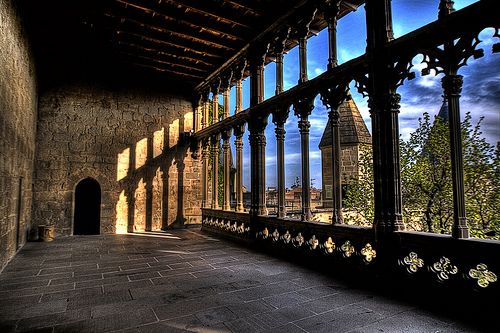
Just one of Spain’s historic and possibly haunted hotels! photo credit: titodixebra Castiellu d’Olite via photopin (license)
10 Palacio de la Alfajeria in Zaragoza
Just 90 mins away from Olite by car, you can visit this wonderful Palace in Zaragoza in the region of Aragon – another region with its own unique history. Aragon’s Mudejar architecture sheds a light on the time of complete harmony between Muslim, Christian and Jewish culture here in Spain. The Mudejar period here began in the 12th century and finished in the 17th century when the Mudejars were first forced to convert to Christianity and were ultimately expelled. In Zaragoza city, you can find at least seven stunning Mudejar buildings within walking distance of each other and the Palace is one of those.
Dating back to the 11th century when it was an Islamic royal palace, today it is home to the Aragon Regional Parliament. As you tour the space, pay special attention to its towers, roof, ceilings and plasterwork as you walk about – you can really appreciate the craftsmanship that runs throughout the building. For more Mudejar architecture read our guide to Zaragoza here. For more architecturally inspiring tours, see the gems we include in our Guide for Architectural Touring in Spain…
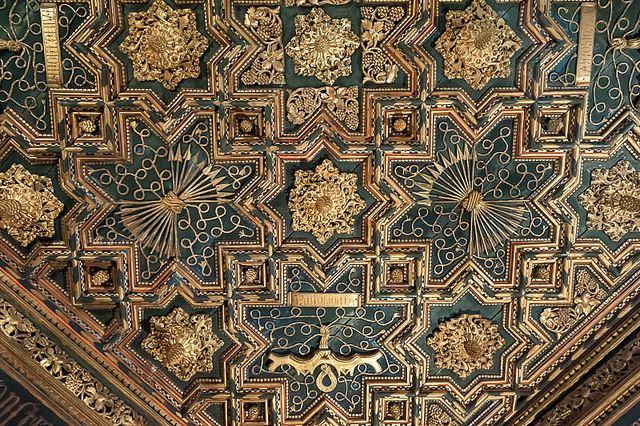
You can really appreciate the craftsmanship that runs throughout the Palace of Alfajeria in Zaragoza in this close-up. Photo credit: jacqueline.poggi via photopin cc
